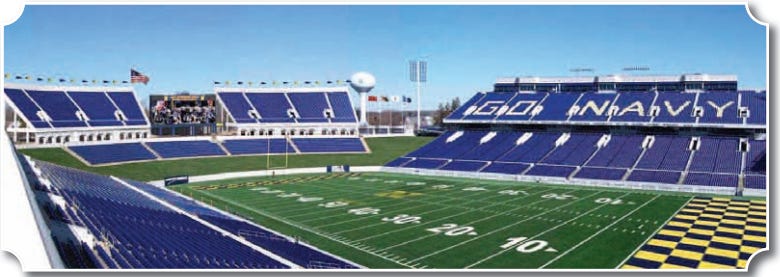Why are Naval Academy football players dying?
In the last seven years, three Midshipmen who played at least two years of football at the US Naval Academy and the Naval Academy Prep School have died of natural causes.
2014: Will McKamey, 19, 5-9, 170-pounds: died after collapsing and falling in to a coma during practice. History of brain injury.
2020: David Forney, 22, 6'3" 305 pounds: died of cardiac arrest in his room.
2021: Michael Myles James, 22, 5'11" 230 pounds (2018): unspecified natural causes in his sleep. Recruited to play football, went to NAPS, played freshman year.
I have kids the same age as these MIDN, that is what first caught my attention. I cannot imagine getting that phone call, or walking it to that room ... it is a living nightmare I would not want to see happen to anyone.
In life, death can happen to anyone and no activity is safe. Football is known to be more dangerous than most sports, and at each level the players and the hits get larger and harder. Still, in a college as small as USNA and with people so young, those numbers seemed unusually large. That got me to start pulling a string.
The Capital Gazette has some interesting numbers we should look at:
This is the 14th midshipman death in eight years, and the second in a year’s time at the academy, according to previous Capital reporting. Midshipman 1st Class John Johnson died in December while on leave.
Johnson is the first midshipman to receive his posthumous degree under a new policy that allows midshipmen who have met the academic requirements for their degrees and are approved by the academic board.
Midshipman 1st Class David Forney and Midshipman 3rd Class Duke Carrillo died in February 2020. Forney, of Walkersville, Maryland, was found unresponsive in his dormitory room Feb. 20. Carrillo, 21, collapsed while taking a physical readiness test Feb. 8 and was later pronounced dead at Anne Arundel Medical Center.
The midshipman will be the fourth off-duty/recreational death in 2021 for the United States Navy, according to the Naval Safety Center statistics. Nine members of the Navy, including Johnson, died while off-duty in 2020.
This is an incomplete dataset that could be improved, but there is more than enough here to start asking some questions. For instance;
- While in the eight-year period there were 14 deaths, it is difficult to break out how many were from accidents. Ideally they should be pulled out of the dataset. If they were, the numbers would be even worse. If I could get a list - I asked a few USNA alumni if there was a memorial page or such that listed MIDN who died while at Annapolis but it appears there isn't - I could pull the name/names off year 8 so as to be the same period of time of 7 years of the football player deaths. That would make the football player percentage even larger as well. We'll stick with what we have and run with it anyway.
- While MIDN James was not on the team this year, he went to NAPS where he played and he played his 4th Class year. Two of his four years he was playing. He counts.
That gets us to the numbers:
- Plus or minus a hundred or so, there are ~4,576 MIDN at Annapolis.
- The last USNA football roster has 104 players. That means 2.3% of the MIDN population is on the football team. If you include people who were once on the team but are not on the roster, a bit more, but not that many more.
- In this eight-year time span football players represented 3/14 deaths. That is 21.4% of the deaths.
That number should concern everyone. That should give pause.
That brings up all sorts of questions:
- In other colleges across the nation, is there a difference between the death rate of football players relative to the rest of the student population? More or less, especially for natural causes?
- If we looked not just as this 8-yr time period at USNA, but further, 15, 20, 25 years, do these numbers hold, or is this simply a "rough spot" in time?
If this is not just a "rough spot in the numbers," then what do you do with this knowledge?




